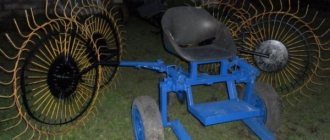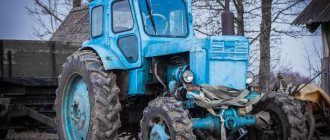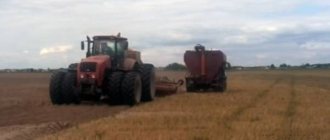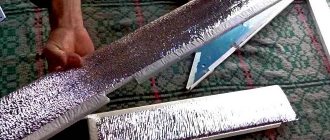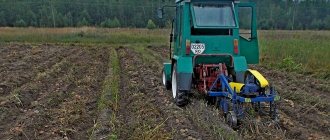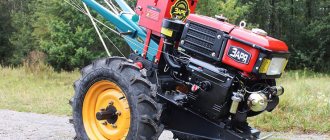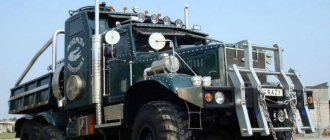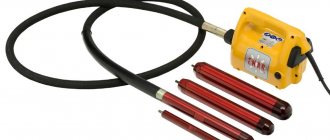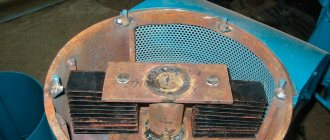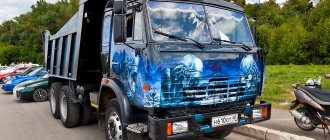The T-40AM universal row-crop wheeled tractor, which was produced at the Lipetsk Tractor Plant (LTZ) from 1972 to 1995, was one of the most successful modifications of the base T-40 model. Thanks to the presence of a front drive axle, the T-40AM has all wheels driven, so it has increased cross-country ability, and this is its main feature.
T-40AM was intended for processing and harvesting row crops, plowing light soils, pre-sowing treatment, sowing, hay harvesting and for transport work. LTZ tractors were highly valued abroad, famous for their durability, high build quality, perfect design and ease of maintenance.
Farmers from New Zealand explained simply and clearly why they choose reliable Lipetsk tractors: “We prefer to work on the tractor rather than under it.” It is not for nothing that the T-40AM tractor was produced for export under the proud name T-40A “Super”.
The wheeled universal row-crop tractor T-40AM with two drive axles and diesel starting with an electric starter or starting gasoline engine belongs to the traction class of 0.9. Thanks to its increased traction and traction properties and high cross-country ability, this tractor has a wide range of applications. According to user reviews, it works easily in swampy areas and is capable of driving through snow and puddles, so it is often used not only on arable land, but also when clearing forests.
The T-40AM was exported under the name “Super”, but people simply call it “Sorokovka”, and they still speak warmly about it, although it would seem that there are more modern machines. T-40AM is a modification of the basic T-40 model, which the designers have modified more than once, striving for perfection. And if now the T-40AM no longer seems to be the pinnacle of technical progress, then in the 1970s it was so.
Correct installation of the MTZ 82 heater
The heating device is installed according to the diagram below.
First of all, you will need to unscrew the bolts that secure the heater to the instrument panel. Then you need to install the rubberized gasket on the existing fan, and then secure the electric motor with nuts. Installing the heater also involves checking the gap between the engine disk and the transverse side of the fan with the permissible value (this value should be less than 10-2 mm). The next step is to drain the liquid from the cooling system. To do this, you will need to remove the plug from the cabin wall, then unscrew the drain valve from the lower radiator pipe. Next, use a fitting to install a rotary angle and secure the heater using clamps. The installation of the unit is completed by fastening to the car interior.
T-40 cockpit conversion
First of all, you need to think about how comfortable you are inside the tractor. Factory sound insulation is not able to reduce the sound of a running diesel engine to an acceptable level, and the standard seat and rigid rear suspension transfer all the vibration to the driver’s back.
To reduce the noise level, it is necessary to dismantle the internal equipment and upholstery of the cabin, and then cover it with special materials. The first layer is vibration insulation StP BiMast or similar with a thickness of 2 to 4 mm. When laying the material, it is desirable to achieve a coverage of 80-100%
Particular attention should be paid to through technological holes, because their presence reduces the noise reduction effect
Isolon (10 mm) or splen (4-8 mm) is laid on top of the vibration-isolating layer. For ease of cleaning, a rubber coating is used as the top layer on the floor. After soundproofing is completed, standard upholstery is installed.
Many people use a car seat as a chair. It will not be possible to achieve a comfortable landing this way, because... the chair does not have a suspension that softens shock loads transmitted to the frame.
They have a spring or pneumatic damper, which increases comfort and reduces fatigue during long-term operation of the equipment.
In most cases, this will be enough for comfortable work in the tractor throughout the day. The remaining changes that are made to the design are individual and are prepared taking into account the needs of the operator. The most common of them are: installing a radio, gas lift for doors, a hand brake mechanism from YuMZ, raising the cab roof, lengthening the gearbox reverse lever and moving the pedals.
An alternative option is to make a homemade cabin. Its design is based on the drawings of the standard design, but with increased proportions.
The frame is made of profile steel pipe (3 mm). The future dimensions of the structure depend on the size of the selected glass with seals. It is preferable to use glass from serial models, since they are cheaper than custom-made ones, and in case of repair it is easier to find a replacement. Plexiglas can also be used to make windows. It is cheaper and easier to process, but becomes cloudy over time. Special places for fixing glass seals are prepared from steel plates 1-2 mm thick in the window openings of the frame.
The entire structure is welded from 4 parts: front, rear and 2 sides. For additional rigidity, the frame is reinforced with gussets at the corners. The doors are made from a profile pipe with 2 mm walls using a similar technology. After preparing all the elements, you can begin the final assembly of the frame. A steel sheet with a thickness of 2 mm is used to make the floor, and 1.2 mm is used for the roof, partitions and dashboard. The cabin will not be inferior to its factory counterparts.
How to make a tractor
When making homemade special equipment, it is necessary to strictly follow the assembly algorithm.
Drawings of homemade models
First of all, you need to carefully examine the drawing with drawings. They will be good helpers during the assembly process. Then you should draw up a plan for the upcoming work and choose a suitable location. Assembly does not take place in 1 day, so it is better to start work immediately in the garage or under a shed.
General progress of work
Assembling a mini tractor includes several stages:
- It is necessary to weld a frame from pipes or channel. To strengthen the structure, the seams need to be welded with scraps of metal corners.
- A steel sheet structure is welded into the front part of the frame - this will be a niche for the power unit. The UAZ engine is mounted in the niche with bolts; additional brackets are used for reliability.
- A seat is installed in the center of the structure.
- Then the brake system from a UAZ SUV is mounted on the frame.
- A linkage mechanism is attached to the rear of the tractor. It is better to purchase a ready-made hitch, because... Manufacturing will require complex turning work.
- If desired, special equipment can be equipped with a cabin. It is necessary to weld the frame and glaze it, you can stretch the awning.
Important Characteristics of the Tatra UDS-114 excavator
After all this, the steering is installed. To simplify the design, the mechanism is mounted on the right side of the frame.
Shortening the rear and front axles
All chassis and transmission parts are installed from the UAZ vehicle.
The rear gearbox will have to be changed a little: on the long axle shaft it is necessary to cut off the flange and drill a hole in the middle. The resulting trim needs to be processed and inserted into the hole made, scald on the outside and trim off the excess. UAZ axles are attached to the V-shaped structure of a homemade frame.
Final touches
After assembling the structure, it is necessary to fill the engine with fuel, oil, coolant and begin testing the equipment. First of all, in order not to overload the power unit, you need to use small cutters and a plow. After checking the mini-tractor on light equipment, you can begin more complex types of work.
Device
In general, the T 40 am is not the most complex tractor in terms of design. Electrical equipment includes a generator, an electric starter, a battery, a pneumatic compressor, and sometimes a hydraulic system, as well as lighting.
Cabin
The cabin is single, closed, made of panels connected by spot welding. The pipe frame ensures safety when tipping over.
A fairly good overview allows you to perform agricultural work efficiently. The windshield is equipped with a windshield wiper.
How to make a stove on a T-40 tractor
Due to the air-cooled internal combustion engine, the Lipetsk tractor is not able to provide adequate heating in the cabin in winter. A way out of this situation may be to manufacture an additional heater. To do this, it is necessary to weld 5-6 longitudinal ribs 3 mm thick and 30 mm high on the engine exhaust manifold. A metal sheet (3 mm) with holes for air intake and supply is welded on top of the resulting radiator. The ends of the structure must be capped.
A turbine fan is installed on the outside of the cabin. It is necessary to lay a pipeline from the cold air supply pipe from the supercharger to the front hole of the radiator, and from the rear hole to the cabin. The entire pipeline is made of metal corrugation with a diameter of 50 mm. The warm section leading into the cabin must be insulated with fiber chimney insulation.
The hot air pipe runs into the lower part of the cabin and is directed to the tractor driver’s feet or the windshield. An additional toggle switch for turning on the turbine fan is displayed on the dashboard. This design ensures the supply of warm air immediately after starting the engine, because the exhaust manifold has a high temperature under any operating modes of the internal combustion engine.
Power, speed, versatility
The basic model T-40 was a universal wheeled tractor of the 0.9 t class for work at high speeds.
The tractor is equipped with a four-cylinder diesel engine D-37M with air cooling and starting from an electric starter. Fuel combustion occurs in a chamber located in the bottom of the piston, which ensures high efficiency of engine operation. The eight-speed manual gearbox has reverse, which allows the tractor to move forward and backward in all gears. For safe operation in the unit with a trailer, a manual lever is installed on the right side of the cab to operate the trailer brakes.
The tractor wheels are equipped with low-pressure pneumatic tires measuring 11-38″. When working in narrow rows, install tires measuring 8.25-40″ or 9-42″. Front wheel size is 6.5-16″. To reduce the towing of the drive wheels when working on wet and light soils, as well as when working with mounted implements that require a large traction force (plowing, deep loosening, etc.), a mechanical additional loader of the drive wheels is used. The track of the rear and front wheels, as well as the ground clearance, are adjustable, which allows the tractor to be used in all standard row spacings of low-stem and high-stem crops.
The steering mechanism is equipped with a hydraulic booster, which facilitates control and ensures the straightness of the tractor and good maneuverability. The longitudinal bars of the semi-frame and the front beam have a standard system of holes for attaching mowers, reapers and other agricultural machines. A hydraulic tow hook allows the tractor driver to attach single-axle transport trolleys to the tractor without leaving the cab.
The T-40 is aggregated with the same agricultural machines with which the DT-24 and T-28 tractors work, and with the majority of agricultural machines designed to work with Belarus-type tractors.
The T-40 was not built right away...
In October 1961, the T-40 tractor successfully passed state tests and was recommended for mass production. In 1962, the LTZ team had to, without stopping the production of T-38 tracked tractors, launch mass production of new universal and high-speed T-40 machines.
However, at the beginning of 1962, specialists were still making endless changes to the components and parts of the tractor. Designers and technologists wanted the machine to be more advanced. If it turned out that some part in the tractor did not meet the necessary requirements, its entire stock was removed from the stream. The production of T-40 tractors began only in 1963, since the reorganization of the plant and the restructuring of production took a lot of time.
Demand is the engine of progress
At the end of the 50s of the 20th century, agriculture needed maneuverable, high-speed, high-performance wheeled tractors. The Lipetsk Tractor Plant began to work to satisfy this need. As usual, it all started difficult - with the reorganization of production, reconstruction of workshops and complete technical re-equipment.
A huge amount of work was done in this direction: 1,200 metal-cutting machines were reinstalled, 400 new ones were installed, production lines were created, a 230 m long conveyor for assembling a wheeled tractor, scraper conveyors with a total length of 1,360 m and inter-shop conveyor lines with a length of 1,850 m.
DIY low pressure tires
Tires of this type visually resemble huge pillows that support the entire structure. The degree of grip in such wheels allows the vehicle to be passable on any off-road terrain. Depending on the design features, such tires are divided into the following types:
- Arched. They are 5 times larger in size compared to a standard wheel, and have a thickness of up to 700 mm. The pressure in them is like in a regular ball - 0.05 MPa. Installed exclusively on the drive drive.
- Wide-profile. They are distinguished by an oval design and pressure up to 2 times lower than standard. Most often used in lifting vehicles.
- Toroidal. They are manufactured in tube and tubeless versions and are highly popular among car enthusiasts.
- Pneumatic rollers, having lugs to improve cross-country ability, and stiffening ribs, giving the entire structure stability and strength.
The cost of factory-made low-pressure tires may be unaffordable for many car enthusiasts. But for your own all-terrain vehicle, it is quite possible to make such a wheel yourself. The work is performed in the following order:
Important Features of operation and manufacture of front loaders on DT-75 and MTZ
1. Selection of source material, for example, agricultural or aircraft tires, as well as other types of industrial transport.
2. The tread is cleaned, washed and dried, after which the desired patterns are drawn to create your own design, as well as to remove excess wire and rubber.
3. To remove excess wire, the inner part of the wheel is trimmed and the cord is removed using a winch.
4. Excess rubber is also removed with a winch, making cuts around the circumference, and securing them to the cable with pliers, carefully pulling them and cutting them with a knife.
5. After removing the tread layer, the surface is cleaned with sandpaper.
6. Disk assembly. To do this, use a standard disk cut in half, or welded from plates and pipes, and then carefully polished to prevent damage to the camera.
7. The tire is pulled onto the rim and secured with belts or a fire hose, and then inflated. The wheel is ready.
What type of tread should I choose for an all-terrain vehicle?
To select the right type of tread for an all-terrain vehicle with low-pressure tires, you need to consider the following factors:
- The protector must have the ability to self-clean. This property is especially important for using an all-terrain vehicle in harsh and wetlands.
- When using an all-terrain vehicle on peat bogs, choose tires with low and shallow terrain, otherwise if their top layer breaks, the grip will be insufficient for full movement.
- When used in snowy areas and on sandstones, tires with a rare pattern are chosen.
Read more: Quick release tip for car compressor
Super models
Based on the T-40 tractor, models were developed that were exported with the designation “Super”. The T-40M was distinguished by a rear drive axle and diesel starting with an electric starter or a starting gasoline engine. A wide range of speeds and reverse for all gears allow the tractor to be used with a large range of agricultural machines and implements and vehicles, both mounted and trailed.
The T-40AM tractor (modification T-40M) with two drive axles and diesel starting with an electric starter or starting gasoline engine has increased cross-country ability. The front drive axle of the tractor turns on and off automatically, depending on road conditions.
The T-40ANM tractor (modification T-40AM) has a reduced overall height and, as a result, increased stability. Designed to perform a range of hay harvesting operations, general purpose work and cargo transportation on slopes up to 16° and on the plain.
Subscribe to our Telegram channel
External tuning MTZ
Tuning Belarus tractors from the outside implies a change in the color scheme of the body. Traditionally, manufacturers supply the market with tractors painted in monochromatic, boring colors. The car owner has plenty of room to roam: he can fully realize his wildest fantasies when painting the body. Tuning the MTZ cabin will transform the unit.
Depending on the wishes of the owner of the equipment, the tractor can be painted completely in a different color, or airbrushing can be used. However, you must understand that before painting the body must be carefully prepared. A drawing, for example, can only be applied to a leveled surface, otherwise it will be distorted.
Hanging a number of decorative elements is also considered as tuning of the MTZ-80. For example, many install moldings, grilles, and make special threshold covers. Sometimes you can even find wheels with hubcaps made by craftsmen with their own hands.
If you decide to tune MTZ YuMZ T-40 tractors, it is important to be aware of how much money and effort will be spent on this. To realize all the ideas, you will need good quality parts and tools that will carry out all the necessary work
You shouldn't skimp on this.
The most difficult part of the work, when tuning on the MTZ-50 is carried out from the outside, as when working with any other model, is the modernization of the body and its components. You can do it yourself by purchasing the necessary parts in specialized stores and modifying them, customizing them to your needs. Sometimes it is better to use the services of specialists who will perform the most complex work to order. Successful external tuning of the MTZ T-40 will be ensured by the rich imagination of the tractor owner.
You can take advantage of the moment and make the tractor the way you always wanted to see it
Attention should be paid to welding seams: they must be made very carefully and properly processed so that corrosion does not occur in the future
Don’t be afraid to use hanging decorative elements - the main thing is not to overdo it with the quantity and not to miscalculate the quality of these components.
Power plant tuning
Its power and equipment performance depend on the stability of the engine. Upgrading a standard engine is very expensive and unpromising. But, there are several ways to make the engine more efficient.
To do this you need:
- Install a quality spark plug. Regularly clean it from carbon deposits and periodically check the clearance. At the first sign of loss of power, replace the spark plug.
- Use the best gaskets on all connections. This allows you to maintain the required pressure in the unit, preventing a decrease in power and the formation of smoke during operation.
- Fill the engine with the best oil to the upper mark. It should be remembered that when the unit is tilted, oil flows away from the rubbing parts.
- Check the quality of fuel before filling the tank. It is advisable to let it sit for a while so that the water sinks to the bottom of the container. The tank itself must be cleaned and wiped dry every 2-3 days.
- Install an additional radiator. To do this, steel plates are welded to the engine housing, which will effectively remove excess heat.
Important: How to assemble a flat-steer all-terrain vehicle on low-pressure tires with your own hands
A radical solution is to replace the power plant with a more powerful and advanced one. Today you can purchase Japanese, Chinese and European engines, which are characterized by high performance and reliability. It is possible that the frame will have to be redesigned to accommodate the new power plant.
Engine D-144
The T-40AM tractor was equipped with a new engine - a four-stroke diesel D-144, equipped with starting from an electric starter or from a starting unit.
The method of mixture formation is an undivided combustion chamber (chamber in the piston). The motor has four separate finned cylinders. The crankshaft is counterweighted, with five main bearings and four connecting rod bearings. The rated power of the diesel engine after 60 hours of operation, including break-in, is 53+5 kW (39+4 hp), operating power – 50+5 kW (37+4 hp). The maximum power at the PTO at the rated crankshaft speed is 48 kW (35.3 hp).
External tuning MTZ
Tuning Belarus tractors from the outside implies a change in the color scheme of the body. Traditionally, manufacturers supply the market with tractors painted in monochromatic, boring colors. The car owner has plenty of room to roam: he can fully realize his wildest fantasies when painting the body. Tuning the MTZ cabin will transform the unit.
Depending on the wishes of the owner of the equipment, the tractor can be painted completely in a different color, or airbrushing can be used. However, you must understand that before painting the body must be carefully prepared. A drawing, for example, can only be applied to a leveled surface, otherwise it will be distorted.
Hanging a number of decorative elements is also considered as tuning of the MTZ-80. For example, many install moldings, grilles, and make special threshold covers. Sometimes you can even find wheels with hubcaps made by craftsmen with their own hands.
If you decide to tune MTZ YuMZ T-40 tractors, it is important to be aware of how much money and effort will be spent on this. To realize all the ideas, you will need good quality parts and tools that will carry out all the necessary work
You shouldn't skimp on this.
The most difficult part of the work, when tuning on the MTZ-50 is carried out from the outside, as when working with any other model, is the modernization of the body and its components. You can do it yourself by purchasing the necessary parts in specialized stores and modifying them, customizing them to your needs. Sometimes it is better to use the services of specialists who will perform the most complex work to order. Successful external tuning of the MTZ T-40 will be ensured by the rich imagination of the tractor owner.
You can take advantage of the moment and make the tractor the way you always wanted to see it
Attention should be paid to welding seams: they must be made very carefully and properly processed so that corrosion does not occur in the future
Front and rear axle conversion
The front axle of the Lipetsk tractor has a design flaw in the spring unit, which leads to the appearance of lateral play and premature failure of the support bearings, king pins, crosspieces and gearbox units. To improve the reliability of the unit and control accuracy, the bridge suspension needs to be modified.
The traverse blocks should be dismantled and the factory pins from the stockings should be cut off (along the weld seam). An electric arc welding machine is used to perform surfacing in the areas of work on the pins. After this, to return the required geometry, they are turned on a lathe, and bolts are welded to the internal parts to secure the king pins in the steering knuckle.
The restored part is welded into its original place. For the steering knuckles, prefabricated spacer bushings (load-bearing and fixing) are machined, which are installed in place of the spring units. During assembly, standard support bearings are used, O-rings are installed under the bushings, and the kingpins are fixed from below the steering knuckles using nuts.
Such a design change will make the tractor more rigid, but will improve handling, reduce the load on the power steering and make the unit more durable. The tractor frame has a large margin of safety, so the increased load on the side members will not affect its service life.
The rear axle only needs modification when using twin rear wheels. To do this, spacers 270-320 mm long are made from thick-walled pipes, which are fastened with standard bolts on the outer sides of the wheels.
